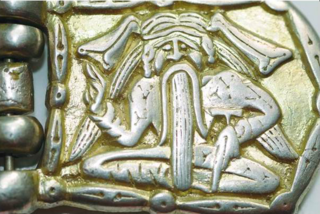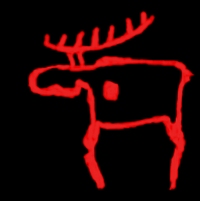
Modern paganism, also known as contemporary paganism and neopaganism, is a type of religion or family of religions influenced by the various historical pre-Christian beliefs of pre-modern peoples in Europe and adjacent areas of North Africa and the Near East. Although they share similarities, contemporary pagan movements are diverse and as a result, they do not share a single set of beliefs, practices, or texts. Scholars of religion often characterise these traditions as new religious movements. Some academics who study the phenomenon treat it as a movement that is divided into different religions while others characterize it as a single religion of which different pagan faiths are denominations.

Ukko, Äijä or Äijö, parallel to Uku in Estonian mythology, is the god of the sky, weather, harvest, and thunder in Finnish mythology.
Finnish mythology commonly refers of the folklore of Finnish paganism, of which a modern revival is practiced by a small percentage of the Finnish people. It has many shared features with Estonian and other Finnic mythologies, but also with neighbouring Baltic, Slavic and, to a lesser extent, Norse mythologies.

Tuonela is the realm of the dead or the Underworld in Finnish mythology. Tuonela, Tuoni, Manala, Vainajala and Mana are used synonymously. Similar realms appear in most Finnic cultural traditions, including among Karelian, Ingrian, and Estonian beliefs. In Estonian mythology, the realm is called Toonela or Manala. Tuonela can also refer to a grave or a graveyard.
A haltija (haltia) is a spirit, gnome, or elf-like creature in Finnish mythology that guards, helps, or protects something or somebody. The word is possibly derived from the Gothic haltijar, which referred to the original settler of a homestead—although this is not the only possible etymology. It can also be derived from the Finnish verb hallita, which means 'to rule', 'to command', 'to master'.

Traditional Sámi spiritual practices and beliefs are based on a type of animism, polytheism, and what anthropologists may consider shamanism. The religious traditions can vary considerably from region to region within Sápmi.

Jumala, Jumal or Jumo (Mari) means "god" in the Finnic languages and those of the Volga Finns, both the Christian God and any other deity of any religion. The word is thought to have been the name of a sky god of the ancient Finnic-speaking peoples. Jumala as a god of the sky is associated with the related Estonian Jumal, Mari Jumo and is thought to stem from an ancient tradition of the Finno-Ugric peoples.
Nature worship also called naturism or physiolatry is any of a variety of religious, spiritual and devotional practices that focus on the worship of the nature spirits considered to be behind the natural phenomena visible throughout nature. A nature deity can be in charge of nature, a place, a biotope, the biosphere, the cosmos, or the universe. Nature worship is often considered the primitive source of modern religious beliefs and can be found in pantheism, panentheism, deism, polytheism, animism, Taoism, totemism, Hinduism, shamanism, some theism and paganism including Wicca. Common to most forms of nature worship is a spiritual focus on the individual's connection and influence on some aspects of the natural world and reverence towards it. Due to their admiration of nature, the works of Edmund Spenser, Anthony Ashley-Cooper and Carl Linnaeus were viewed as nature worship.

Modern Finnish paganism, also known as Finnish neopaganism or the Finnish native faith, is the contemporary revival of Finnish paganism, the pre-Christian polytheistic ethnic religion of the Finns. A precursor movement was the Ukonusko of the early 20th century. The main problem in the revival of Finnish paganism is the nature of pre-Christian Finnish culture, which relied on oral tradition which may be subject to change over time. The primary sources concerning Finnish native culture are written by latter-era Christians.

Celtic neopaganism refers to any type of modern paganism or contemporary pagan movements based on the ancient Celtic religion. One approach is Celtic Reconstructionism (CR), which emphasizes historical accuracy in reviving Celtic traditions. CR practitioners rely on historical sources and archaeology for their rituals and beliefs, including offerings to spirits and deities. Language study and preservation are essential, and daily life often incorporates ritual elements. While distinct from eclectic pagan and neopagan witchcraft traditions, there is some overlap with Neo-druidism.

Hungarian mythology includes the myths, legends, folk tales, fairy tales and gods of the Hungarians, also known as the Magyarok.
Soul dualism, also called dualistic pluralism or multiple souls, is a range of beliefs that a person has two or more kinds of souls. In many cases, one of the souls is associated with body functions and the other one can leave the body. Sometimes the plethora of soul types can be even more complex. Sometimes, a shaman's "free soul" may be held to be able to undertake a spirit journey.
In Finnish folklore, Kalma is an abstraction or a personification of death or the grave. The word kalma means 'a grave, the smell of a corpse, a corpse'. It has cognates in other Uralic languages. In Samoyed languages kolmu or halmer means 'corpse' or 'the spirit of a dead person'. In Mordvinic languages, kalma or kalmo means 'grave'.
Finnic mythologies are the mythologies of the various Finnic peoples:
Elements of a Proto-Uralic religion can be recovered from reconstructions of the Proto-Uralic language.

Estonian neopaganism, or the Estonian native faith, spans various contemporary revivals of the indigenous religion of the Estonian people, adapted from their local myths and culture.

Tietäjä is a magically powerful figure in traditional Finno-Karelian culture, whose supernatural powers arise from his great knowledge.
Uralic neopaganism encompasses contemporary movements which have been reviving or revitalising the ethnic religions of the various peoples who speak Uralic languages. The movement has taken place since the 1980s and 1990s, after the collapse of the Soviet Union and alongside the ethnonational and cultural reawakening of the Finnic peoples of Russia, the Estonians and the Finns. In fact, Neopagan movements in Finland and Estonia have much older roots, dating from the early 20th century.
Karhun kansa (Finnish:['kɑrhunˈkɑnsɑ] is a religious community based on indigenous Finnish spiritual tradition. The community was officially recognized by the Finnish state in December 2013. "Karhun kansa" is Finnish for "People of the Bear". The bear, known as Otso, is the most sacred animal in the Finnish spiritual tradition, and said to be the mythical ancestor of all humankind. Karhun kansa is part of Suomenusko, the contemporary revival of pre-Christian polytheistic ethnic religion of the Finns. Some members of Karhun kansa call their faith 'väenusko' rather than 'suomenusko'. The first part of the term 'väenusko' stems from a Finnish word 'väki', which refers to people, and also both unseen and visible powers that are part of traditional Finnic mythology.



















